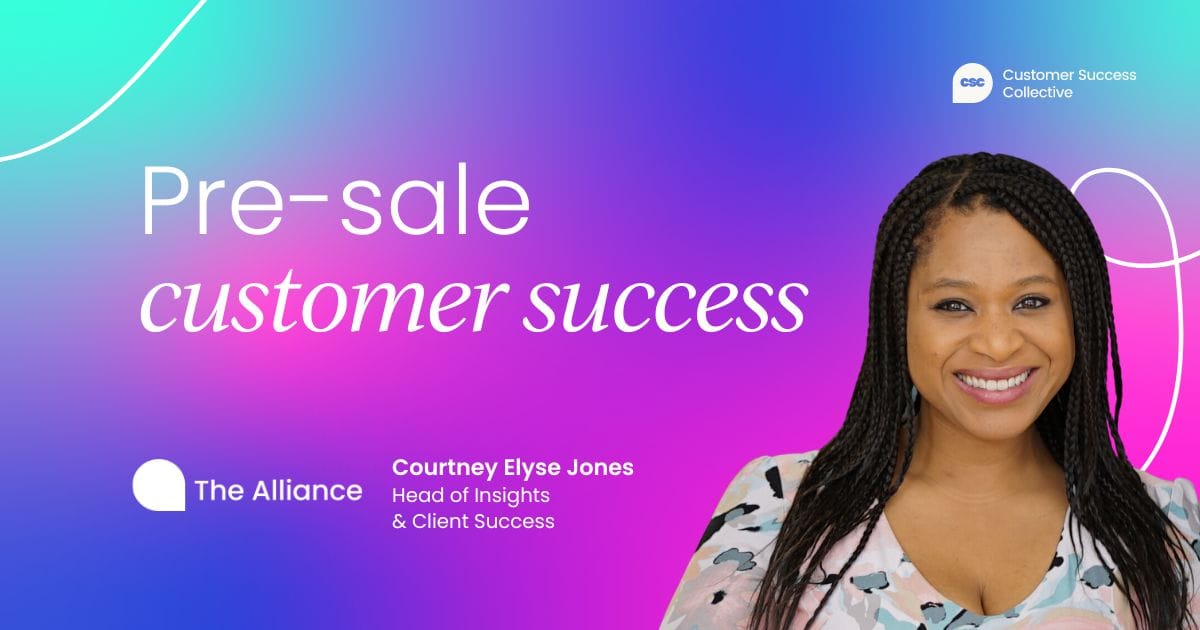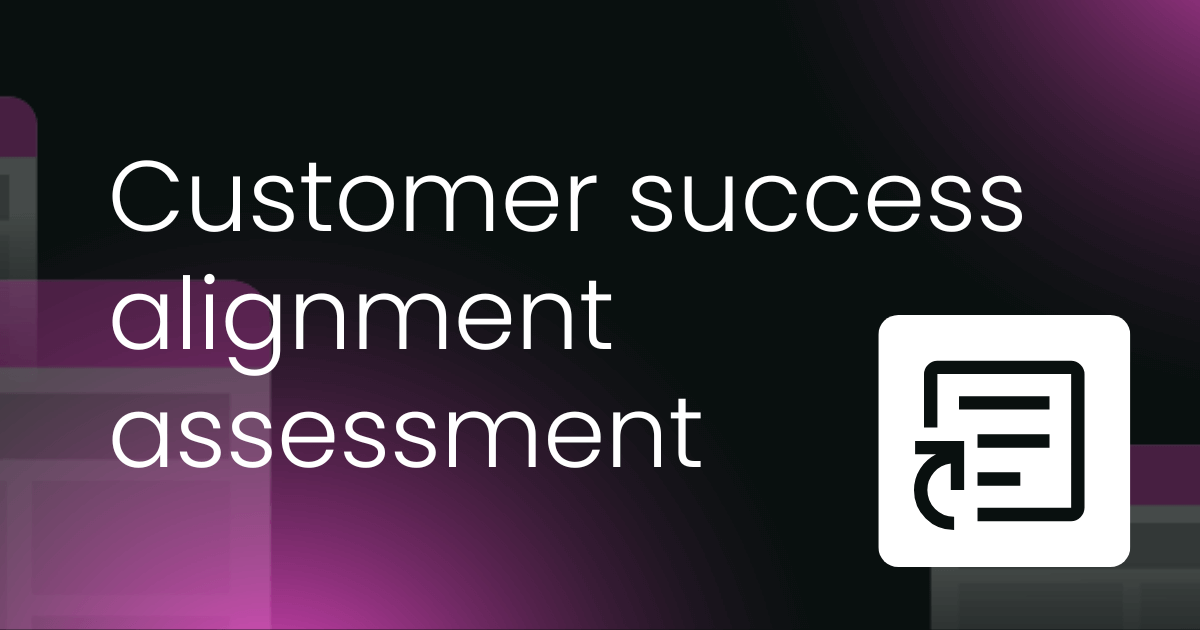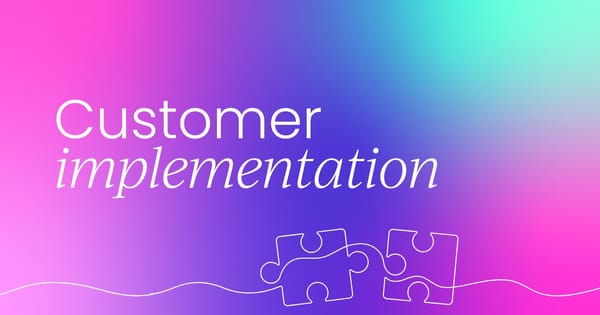One of the most complex yet often misunderstood aspects of customer success is implementation. It's the critical bridge between sealing the deal and driving long-term adoption – a phase that sets the tone for the entire customer relationship. But implementation isn't onboarding, nor is it adoption.
In some companies, these three may blur into one; but they're three critically different stages of the customer journey.
Execute implementation poorly, and you risk eroding hard-won trust, frustrating customers, and stalling value realization. Because let’s face it – you're not just implementing a product or a platform – you're building a partnership. And like any good partnership, it requires patience, understanding, and a commitment to mutual success
Fortunately, there are strategies, frameworks, and best practices that can aid your path to success.
So if you're looking to take your implementation game to the next level – whether you're a seasoned CS leader or just starting out – read on.
- What is customer implementation?
- Promote a self-sufficient ethos
- Pre-sale customer success
- The sales-to-customer success handoff
- Balancing customization with value delivery
- Ensuring proper stakeholder involvement
- Measuring implementation success
- Continuous alignment and support
- Avoid common implementation pitfalls
- Post-implementation success
- Future-proofing your implementation process
The roadmap to frictionless onboarding, sustained adoption, and guaranteed renewals awaits you…
What is customer implementation?
Implementation is a clearly defined phase focused on setting up the product to meet the customer's needs.
During the implementation phase, you'll typically have very few users in the platform, and the focus is primarily on building, configuring and training this core group.
Implementation follows set timelines, objectives, and standardized processes to get the product technically ready for the customer’s environment. It's typically a short-term project (although it can be longer) that concludes with a “launch” of the platform, ready for users to begin their journey.
What is the difference between implementation and onboarding?
Onboarding, by contrast, extends beyond the initial setup of implementation. This phase is about engaging customers, building trust, and setting a long-term roadmap for success.
As Dominic Constandi, Chief Customer Officer at Sovosi, explains, “Each phase is cumulative, setting up the next phase for success, much like an athlete prepares for a tournament.”
While implementation provides a technical foundation, onboarding guides customers into a deeper relationship with the product and the team, helping them understand the platform’s potential and the steps needed to reach their desired outcomes.
What is the difference between implementation and adoption?
Adoption follows the implementation and onboarding phases and is an ongoing process.
Here, customer success managers (CSMs) actively support users as they begin engaging fully with the platform, applying best practices, and addressing specific pain points.
Adoption is where users start realizing the platform’s value in their daily workflows, and it requires continual engagement from the CS team to ensure users see the benefits, maintain momentum, and expand their use of the product. Unlike implementation, adoption is an ongoing commitment that helps sustain excitement and value over the long term.
Implementation can include an additional adoption phase that follows the launch, covering elements like end-user training and best practice recommendations.
Together, these phases create a cumulative journey, guiding customers from setup to engaged use, and ultimately to fully realizing the platform’s value.
Implementation vs. customer onboarding
The differences between customer implementation and onboarding go beyond mere semantics; implementation is only one component of the onboarding journey.
It serves as a foundational step, while onboarding extends further to engage customers, build trust, and establish a roadmap to long-term success. To reflect on the words of Dominic Constandi, Chief Customer Officer at Sovosi:
"Each phase is cumulative, setting up the next phase for success, much like an athlete prepares for a tournament."
Promote a self-sufficient ethos
If you want your customers to adopt your product, renew, and then become advocates, you’ve got to mold them into product experts from day one.
Your implementation process needs to be built to cultivate product experts early on in your partnership.
If your product is intuitive to use and has been built on user feedback, this approach will deliver on one of your product’s key advantages: that your customers don't need a full-time admin dedicated to managing your product. They should be able to use your product, or platform, without resistance.
The benefits of this approach are twofold:
- It empowers admin users to self-serve on future configuration enhancements, and
- It creates platform champions who feel confident enough to get creative within the platform and advocate for it internally.
This strategy has proven particularly effective in encouraging customers to iterate and innovate within the platform without being blocked by knowledge gaps.

Pre-sale customer success
Implementation has its similarities to the dating phase of a relationship.
Let’s say you've swiped right on Tinder or Hinge; you discuss what you want in your future, and you've agreed that you're on the same page. Now you're just trying to understand the other person and see if you can make the future a reality. It’s very much an “Is this the right fit?” kind of moment.
But the seed of customer success can be brought in before the point of sale – during the sales process itself. CSMs can be brought into sales calls to identify the prospect’s key challenges and align on the right solution.
When he was Senior Director, Customer Success (EMEA) at Procure Technologies, Richard Cookson took part in a panel discussion on sales and success alignment at Customer Success Festival London 2022.
Richard emphasized the importance of establishing clear roles and responsibilities early on, highlighting a structured approach to customer implementation and onboarding.
In his process, CSMs play an active role even in the pre-sales phase, enabling them to build key relationships, clarify goals, and understand the customer's unique pain points well before implementation begins.
In Richard’s words:
“For our larger customers, we get CSMs involved in pre-sales. That’s really important to start introducing the roles, building relationships, understanding pain points… and scoping out professional services so we can deliver the right implementation based on the complexity and size of the business.”
When you integrate CS into the pre-sales process, the prospect is familiarized with the expectations and goals that will drive the subsequent implementation phase. This seamless transition from sales to onboarding helps establish trust and transparency from the very start.

The sales-to-customer success handoff
“You can't complete the implementation just by getting a good handoff. But you can certainly blow up the whole thing by having a bad handoff and a bad kick-off.”
– Dominic Constandi, Chief Customer Officer at Sovosi
Mastering a good relationship with your sales team is critical for implementation. Unfortunately, cracks can start to form as early as onboarding due to improper handovers from the sales representative to the customer success manager.
When sales and CS teams don't have proper processes and documentation in place, crucial details about customizations or deadlines can be missed. The result? Generic implementation plans that miss the mark and erode customer trust.
To avoid this, you should always champion clear communication, standardized documentation, and seamless transitions between your two teams. By the time the implementation phase begins, the necessary stakeholders – from technical experts to executive sponsors – should all be aligned and ready to execute the vision outlined during the sales process.
According to Richard Cookson, after the sale is closed, they hold an internal kickoff to ensure all relevant stakeholders, from customer success to technical experts, are fully briefed. This reduces duplication and supports a well-informed transition.
He notes, “The North Star is pretty much the same with everyone. It’s how do you reduce duplication and transfer all of that knowledge from pre-sales right through the customer journey.”
This proactive, structured approach to knowledge transfer and stakeholder involvement reduces the risk of a cold handoff. From this point, the implementation team can focus on balancing customized needs with consistent value delivery, which we’ll cover in the next section.
Balancing customization with value delivery
As you’ll have guessed by now, implementation is a complex beast.
It’s important to approach it with caution, ensuring you don’t enter the process gung-ho, but without much thought. It’s important to break down implementation into manageable phases, to ensure your customers receive a steady stream of impactful wins, rather than feeling overwhelmed by the sheer scope of your product.
The core tenets of this methodical approach:
- Identify mission-critical workflows as the initial implementation focus
- Gradually increase complexity and functionality over time
- Maintain a regular cadence of tangible value delivery at each phase
- Keep customers confident and engaged throughout the journey
This carefully orchestrated rollout stands in stark contrast to the "all-or-nothing" implementation that can all too easily backfire, leaving customers frustrated and unsure of your product’s true capabilities.

Ensuring proper stakeholder involvement
Put simply, implementation won’t be successful without the full cooperation of every team member and stakeholder.
The process begins with a sales development representative (SDR) engaging your client decision-makers, followed by customer success managers or account managers discussing partnership goals, and a product manager addressing technical questions.
By the time the implementation team enters the picture, all key personas should be identified:
- Customer success managers, account executives, product managers
- Technical stakeholders
- Executive sponsors

Measuring implementation success
Beyond standard metrics like time to launch and daily active usage, you can track success across three key areas:
- Solution maturity
- Customer experience
- Product adoption
In terms of qualitative measures, you can also examine direct customer feedback through questions like, "If you could renew tomorrow, would you?" This combination of quantitative and qualitative metrics helps ensure both immediate and long-term success.
Continuous alignment and support
Successful implementation isn't just about following a process – it's about maintaining continuous alignment with your customer's goals. This can happen through several key touchpoints:
- Sales handoff
- Customer onboarding kickoff
- Post-implementation review
- Regular milestone check-ins
During these touchpoints, your CSMs tackling implementation should validate that they're working towards the customer's key goals and moments of impact. Ultimately, there shouldn’t be any nasty surprises once you get to the renewal stage where you have a customer saying, “But this didn't go at all as expected!”

Avoid common implementation pitfalls
One big hurdle you’ll inevitably face is the challenge of working with new stakeholders who might lack organizational context. For instance, if your point of contact in your client’s organization is new to their company, they might not have the historical knowledge needed to roll out your SaaS product effectively.
The solution? We recommend bringing in additional thought leaders who can provide the necessary context. In the case of a SaaS platform, you run the risk of building out an entire instance based on one person's limited perspective, potentially requiring a complete rebuild of your product before going live.
Post-implementation success
The end of implementation isn't really an end at all – it's a transition. Once the initial build is complete, you can focus on:
- Reviewing what's been built
- Recommending enhancements
- Suggesting adoption strategies based on initial usage patterns
- Transitioning to a dedicated customer success manager or account executive
This is where the old "teach them to fish" philosophy really shows its value. Customers should feel confident not just in using the platform, but in continuing to mature their usage.
Future-proofing your implementation process
Here are key considerations for building a sustainable implementation process:
- Documentation: Maintain clear processes and standardized handoff procedures between sales and CS teams.
- Stakeholder management: Ensure you have the right mix of technical and business stakeholders involved from the start.
- Value alignment: Continuously validate that implementation activities align with the customer's key goals.
- Feedback loops: Implement regular check-ins and surveys to gather both quantitative and qualitative feedback.
Key takeaways for customer success managers
The first 90 days of your customer relationship are crucial for long-term success. It's during this period that customers form their first impressions of your platform's capabilities and your team's ability to mitigate risks.
Success in implementation requires:
- Clear distinction between the implementation and adoption phases
- Strong alignment between sales and customer success teams
- A methodical approach to feature rollout
- Proper stakeholder involvement from day one
- Comprehensive success metrics
Above all, remember that successful implementation isn't about rushing to get everything done at once. Implementation sets the foundation for your entire customer relationship; get it right, and you're well on your way to building strong, lasting partnerships that drive value for both parties.
The implementation phase sets the tone for your entire customer relationship. Take a methodical approach to ensure genuine stakeholder involvement, and maintain clear communication throughout. Doing this might seem like a lot of up-front work, but the payoff is undeniable – you’re creating a strong foundation for long-term customer success.
Keep on learning
Want to learn more about customer implementation and other customer success topics?
Join our global community on Slack for the head-scratching questions you want answered and the connections you haven’t made yet.



 Follow us on LinkedIn
Follow us on LinkedIn








